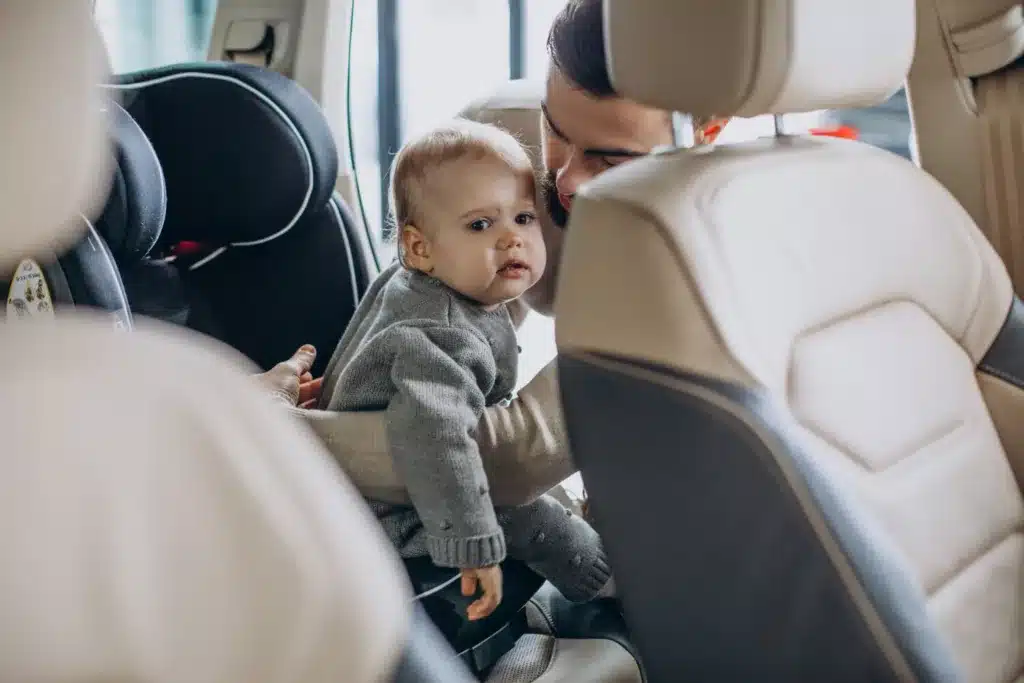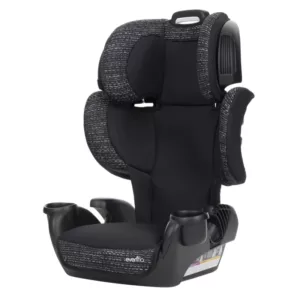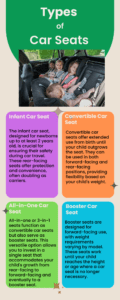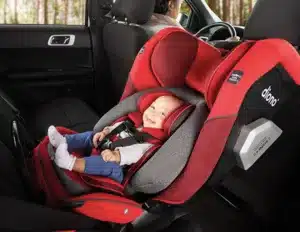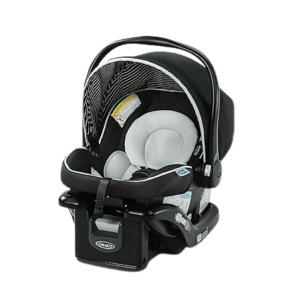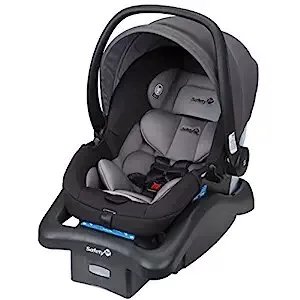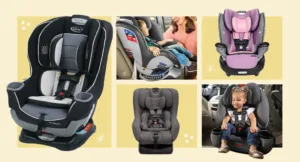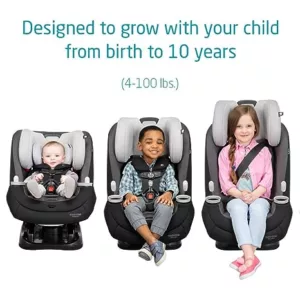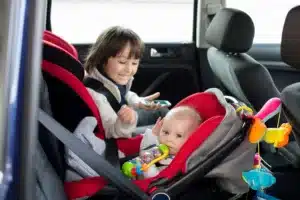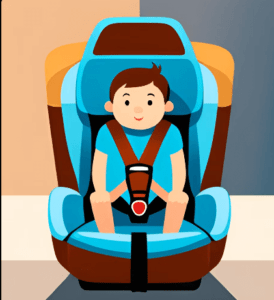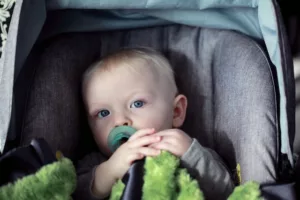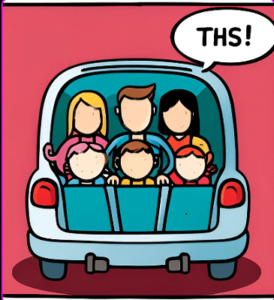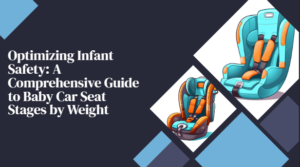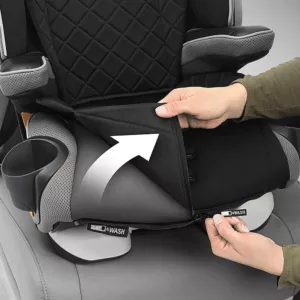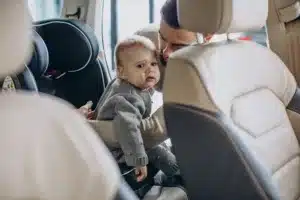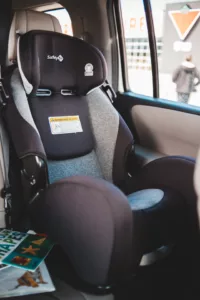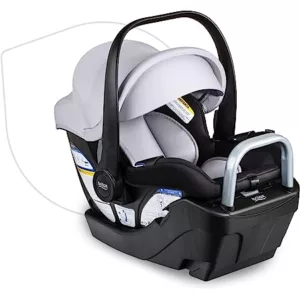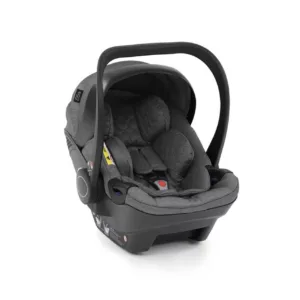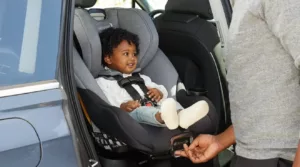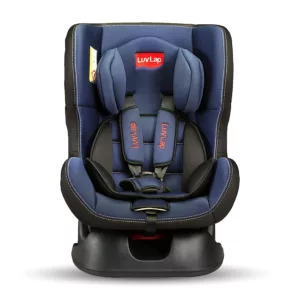How to dispose of a child’s expired car seat? Learn in our comprehensive guide for ensuring child safety and environmental guard.
Thank you for reading this post, don't forget to subscribe!Child safety is paramount for every parent and caregiver, especially when traveling in vehicles. The trust we place in car seats to protect our little ones during journeys is immeasurable. However, as responsible guardians, we must also consider the lifecycle of these essential safety devices. Like many other products, car seats come with an expiration date, and understanding how to disposing of child-expired car seats is crucial for the safety of future passengers and our environment.
This comprehensive guide will delve into the critical matter of disposing of a child’s expired car seats safely and responsibly. This article will not only shed light on why car seats expire, and the potential safety risks associated with using expired ones but also emphasize the environmental impact of improper disposal. We will explore various disposal options, from recycling to repurposing, and provide step-by-step instructions to ensure you make informed choices.
As we embark on this journey together, we will reinforce that child safety and environmental responsibility go hand in hand. Let’s explore the many facets of proper car seat disposal and work together to protect our children and contribute to a sustainable future.
Why Car Seats Expire – Dispose of a Child’s Expired Car Seat
Car seats are designed with a single, crucial purpose: to keep our children safe during car rides. Yet, over time, these safety devices undergo modifications that can greatly influence their effectiveness in fulfilling this crucial role. Grasping the reasons behind car seat expiration is the initial stride towards guaranteeing your child’s safety during road travel.
Table of Contents
ToggleStructural Integrity – Dispose of a Child’s Expired Car Seat
Car seats are meticulously engineered to withstand the forces exerted during a collision. Over time, materials like plastic and foam can deteriorate due to exposure to sunlight, temperature fluctuations, and general wear and tear. This gradual degradation affects the seat’s structural integrity, jeopardizing its capacity to safeguard your child in case of a collision.
Child Safety Regulations – Retired Child’s Car Seat
Technologies are in a constant state of evolution. Innovations and research led to the development of safer car seat designs. Expired car seats may need to meet the latest safety standards, lacking critical features that could enhance your child’s protection. Adhering to expiration dates ensures your child travels in a seat that conforms to the most up-to-date safety requirements.
Weakened Components – Dispose of a Child’s Car seat
The individual components of a car seat, such as harness straps, buckles, and padding, are subject to wear and tear. Over time, these components can weaken, making them less effective at securely restraining your child. In a collision, these cut parts may not provide the same level of protection as they did when the seat was new.
The Consequences of Ignoring Expiration Dates – Proper Dispose of a Child’s Car Seat
Now, let’s consider these reasons with a few startling statistics and real-life examples. According to research, many car seats are used beyond their expiration dates, putting children at risk. Over 60% of car seats are used improperly, which includes using an expired car seat.
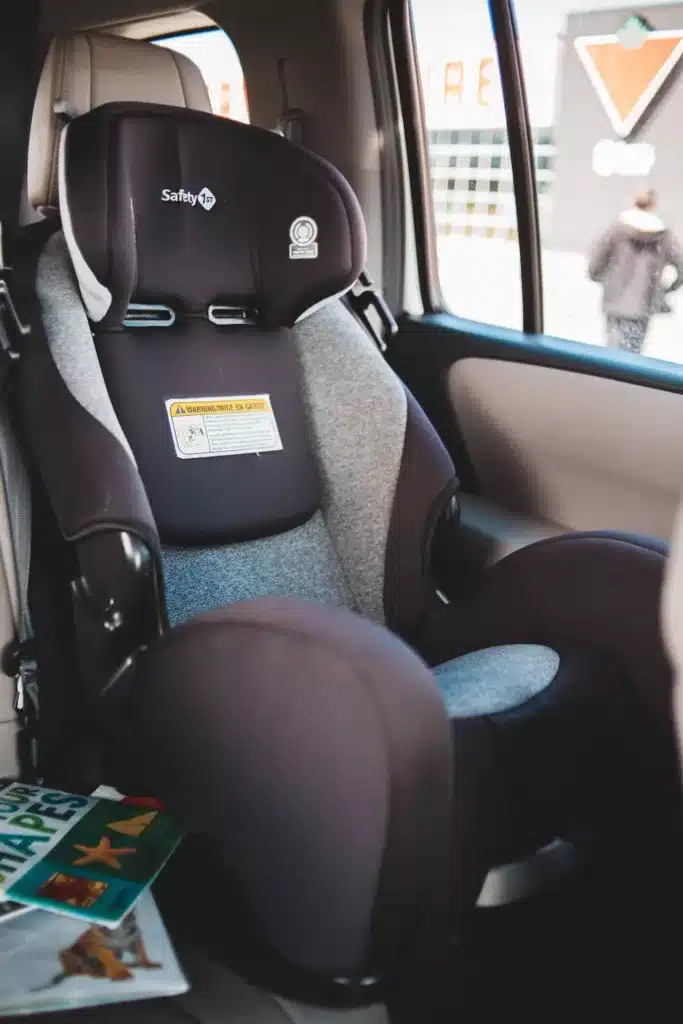
Consider this Scenario
You’re on a road trip with your family and see a car seat for sale at a garage sale or online marketplace. It looks pristine, and the price is tempting. You might think, “Why spend more on a new one when this one look perfectly fine?” I’m sorry, but that’s a risk you should always avoid. You can’t be certain of its history, and an expired or damaged car seat could fail to protect a child in a critical moment, no matter how good it looks.
The consequences of ignoring expiration dates on car seats can be devastating. In accidents, expired car seats may not provide the protection needed, leading to severe injuries or worse. It’s a risk we should never be willing to take when it comes to the safety of our precious passengers.
Understanding these reasons and statistics reinforces the importance of adhering to car seat expiration dates. As responsible caregivers, we must prioritize our children’s safety above all else and recognize that using an expired car seat is not worth the risk.
Safety Risks of Using Child Expired Car Seat – Timely dispose of a Child’s Expired Car Seat
Using an expired car seat for your child may seem like a minor oversight, but it can have profound and potentially life-threatening consequences. To underscore the gravity of this issue, let’s delve deeper into the potential safety hazards associated with using expired car seats, share real-life stories or examples of accidents involving expired seats, and emphasize the crucial responsibility that parents and caregivers bear in ensuring the safety of their precious passengers.
Decreased Structural Integrity
As car seats age, the material and foam can deteriorate. This gradual degradation affects the structural integrity of the seat.
In a collision or sudden stop, an expired car seat may not provide the same level of protection it once did. Cracks, weakened connections, or compromised components can fail to absorb and distribute impact forces, putting your child at risk of injury.
Outdated Safety Standards – Timely dispose of a Child’s Expired Car Seat
Child safety continuously evolves, with researchers and engineers developing better ways to protect young passengers. It leads to frequent updates in safety standards and regulations.
Expired car seats may not adhere to the latest safety standards, lacking the advancements and features that could significantly improve your child’s protection. The safety technology in an expired seat might be years behind what is currently available.
Weakened Components – Dispose of a Child’s Expired Car Seat
The harness straps, buckles, and padding of a car seat can wear out or degrade over time, especially with regular use and exposure to environmental factors.
This deterioration may impact the seat’s ability to restrain your child during a crash securely. For instance, a weakened harness strap may not hold your child in place as effectively, increasing the risk of injury.
Real-Life Consequences
Unfortunately, there are heartbreaking stories of accidents involving expired car seats that serve as stark reminders of the risks. These stories are not just statistics but represent the lives and families affected by this critical issue.
One such incident involved a family who unknowingly used an expired car seat for their toddler. In a collision, the seat failed to protect the child adequately, resulting in serious injuries.
These real-life examples underscore the importance of heeding expiration dates and taking every precaution to ensure your child’s safety while traveling.
The Responsibility of Parents and Caregivers – Dispose of a Child’s Expired Car Seat
As parents and caregivers, we are profoundly responsible for protecting our children. It extends beyond providing love and care, including safeguarding their lives during every car journey.
We must educate ourselves about car seat expiration dates and check our child’s car seat for this critical information.
Always remember that your child relies on you for their safety. Using an expired car seat compromises their well-being and risks severe consequences.
The safety risks of using expired car seats are not underestimated. The potential consequences are dire, and the responsibility for ensuring child safety falls squarely on the shoulders of parents and caregivers. Our children’s emotional and physical well-being must always take precedence over convenience or cost savings.
Options to Dispose of Child’s Expired Car Seat
As you come to terms with the importance of retiring a child’s expired car seat for your child and others’ safety, you may wonder about the best ways to disposing of child expired car seats responsibly. Fortunately, several options are available, each with its unique benefits. Let’s delve into these alternatives extensively to assist you in making a well-informed choice:
Recycling – Responsibly dispose of a Child’s Expired Car Seat
Recycling your expired car seat is an eco-friendly choice that keeps it out of landfills, reduces waste, and conserves resources. Recycling just one car seat can divert 11 pounds of plastic from landfills.

Steps to Follow – Dispose of a Child’s Expired Car Seat
- Research local recycling options or programs that accept baby car seats for proper processing.
- Contact recycling facilities to inquire about their policies and procedures for car seat recycling.
- Prepare the car seat by removing fabric covers, padding, and harness straps to ensure it can be recycled effectively.
Manufacturer Take-Back Programs – Dispose of a Retired Child’s Car Seat
Many car seat manufacturers have established take-back programs to facilitate the proper disposal of expired seats. Participating in these programs supports a circular economy and the manufacturer’s commitment to safety and sustainability.
Steps to Follow – Dispose of a Child’s Expired Car Seat Via Manufacturers Take-Back
- Contact the manufacturer of your car seat to inquire about their take-back initiatives.
- Follow their instructions for returning the expired seat, which may involve shipping it to a designated location.
- Ensure you adhere to any packaging or labeling requirements provided by the manufacturer.
Donation – A Way to dispose of a Child’s Expired Car Seat
Donating a car seat may help families in need who cannot afford new seats. However, this option comes with specific considerations (discussed later).
Steps to Follow
- Verify the car seat’s expiration date to ensure it is still within its usable period.
- Contact local charitable organizations, women’s shelters, or parenting support groups to inquire if they accept used car seat donations.
- Ensure the recipient knows the expiration date and the seat’s history.
Repurposing – Dispose of a Child’s Expired Car Seat
Repurposing car seat components can be a creative and sustainable way to extend their usefulness while reducing waste.
Steps to Follow
- Consider transforming the car seat’s plastic shell into a unique playtime prop, a creative planter, or a pet bed.
- Separate metal parts, like buckles and frames, and recycle them at local scrap metal facilities.
- Share your repurposing ideas with others to inspire sustainable creativity.
Safe Disposal – Dispose of a Child’s Expired Car Seat
If other options are not feasible, safe disposal ensures the car seat will not be used by unsuspecting families, minimizing potential risks.
Steps to Follow
- Render the expired car seat inoperable by cutting the harness straps, removing padding or covers, and separating detachable parts.
- Consult local waste management guidelines to ensure compliant disposal, adhere to regulations, and minimize potential hazards.
- Follow any specific packaging or labeling instructions provided by local waste management authorities.
It’s important to note that each disposal option may have specific requirements, conditions, and availability depending on your location. Always confirm the details and availability of recycling programs, manufacturer take-back initiatives, and other disposal methods in your area, as they may vary based on your region’s resources and regulations.
By choosing one of these responsible disposal options, you prioritize child safety and contribute to a more sustainable and environmentally conscious future.

Recycling Programs and Local Options – Dispose of a Child’s Expired Car Seat
Recycling is a powerful way to give expired car seats a second life while contributing to a cleaner and more sustainable environment. In this section, we’ll discuss recycling programs for car seats, how to find local recycling options, highlight the benefits of recycling car seats, and provide practical tips for preparing your car seat for recycling.
Recycling Programs for Car Seats
Many communities and regions have recognized the environmental impact of disposing of car seats in landfills and have established recycling programs to address this issue.
These programs are designed to collect and process expired car seats in an environmentally responsible manner, ensuring that their components are recycled or repurposed, thus diverting them from landfills.
How to Find Local Recycling Options – Dispose of a Baby’s Retired Car Seat
To discover recycling options for car seats in your area, start by:
- Contacting Local Recycling Centers: Contact your local recycling centers or waste management facilities to inquire if they accept baby car seats for recycling.
- Online Resources: Utilize online resources such as recycling directories or environmental organizations’ websites to find information about nearby recycling programs.
- Community Events: Keep an eye on community recycling events that may specifically address baby gear, including car seats, often organized by municipalities, community groups, or environmental organizations.
Benefits of Recycling Car Seats
Recycling expired car seats offers several compelling benefits:
- Reduction of Landfill Waste: Disposing car seats in landfills contributes to unnecessary waste and takes up valuable landfill space. Recycling diverts these bulky items from landfills.
- Resource Conservation: Car seats are typically made of materials like plastic, metal, and fabric, which require substantial resources to produce. Recycling these materials conserves valuable resources and reduces the need for new raw materials.
- Environmental Protection: Recycling prevents the release of harmful pollutants and greenhouse gases that can result from car seats decomposing in landfills or being incinerated.
Tips for Preparing Car Seats for Recycling
Before recycling your expired car seat, it’s essential to prepare it properly to facilitate the recycling process effectively. Here are some tips:
- Remove Fabric and Padding: Remove fabric covers, padding, and harness straps. Usually, these elements are non-recyclable and should be discarded separately. Separate Metal Parts: If your car seat has metal components like buckles and frames, separate them for recycling at local scrap metal facilities.
- Follow Recycling Program Guidelines: Recycling programs may have specific requirements or conditions for accepting baby car seats. Always follow any preparation or packaging instructions the recycling program provides to ensure your car seat is recycled efficiently.
By participating in recycling programs or seeking local recycling options, you dispose of your expired car seat responsibly and contribute to reducing waste, conserving resources, and protecting the environment. Recycling is a meaningful way to extend the life cycle of car seats and promote sustainable practices within your community.
Manufacturer Take-Back Programs – Dispose of a Child’s Expired Car Seat
Manufacturer take-back programs offer a responsible and eco-conscious way to disposing of child expired car seats. Car seat manufacturers establish these programs to facilitate the proper disposal and recycling of old and expired seats. In this section, we’ll explore how manufacturer take-back programs work, list some well-known car seat brands that offer such programs, and encourage readers to visit the manufacturer’s websites for the latest and most current information.
How Do Manufacturer Take-Back Programs Work?
Collection Initiatives: Car seat manufacturers set up collection initiatives to gather expired seats from consumers. These initiatives can take various forms, such as drop-off locations or mail-in programs.
- Return Instructions: Manufacturers provide clear instructions on how consumers can return their expired car seats. It often includes details on packaging, labeling, and shipping.
- Responsible Disposal: Once the expired car seats are returned, manufacturers ensure that the seats are discarded or processed eco-consciously. They may work with recycling facilities or partners to process the materials.
Car Seat Brands Offering Manufacturer Take-Back Programs – Dispose of a Child’s Expired Car Seat
While specific take-back programs for baby car seats may vary over time and across different regions, here are a few well-known car seat brands that have previously offered or currently offer such programs:
Britax: Britax has been known to have a take-back program for their car seats, allowing customers to return expired or damaged seats for recycling. We urge readers to contact Britax directly or browse their website for the latest details regarding their take-back program.
Graco: Graco has also offered a take-back program in the past. They have facilitated the recycling of car seats through designated events or partnering with recycling organizations. Check Graco’s website or contact customer service for their current take-back program information.
Evenflo: Evenflo has implemented a recycling program called the “Evenflo Car Seat Recycling Program” in collaboration with Teracycle. This program allows customers to send in their expired or damaged car seats to be recycled. Visit Evenflo’s website for more details and to participate in their recycling program.
Maxi-Cosi: Maxi-Cosi has initiated a take-back program called the “Maxi-Cosi Recycling Program” in select regions. This program encourages customers to return their expired car seats to be recycled responsibly. Check Maxi-Cosi’s website or contact their customer service for information on the availability of their take-back program in your area.
Checking Manufacturer Websites for the Most Up-to-Date Information – Dispose of a Child’s Expired Car Seat
It’s important to note that the availability and details of take-back programs may change over time and vary by region. Therefore, readers are encouraged to visit the official websites of car seat manufacturers for the most accurate and up-to-date information regarding their take-back programs for baby car seats. Manufacturer websites often provide comprehensive guidance on participating in these programs and ensure to dispose of a child’s expired car seat responsibly.
By taking advantage of manufacturer take-back programs, you contribute to the proper disposal of expired car seats and support a circular economy and the manufacturer’s commitment to safety and sustainability. Always verify program details with the manufacturer to ensure you follow the latest responsible car seat disposal guidelines.
Repurposing and Creative Ideas for Disposing of a Child Expired Car Seat
Repurposing old car seat components is an imaginative and sustainable way to extend the lifespan of these safety devices while reducing waste. In this section, we’ll share creative ways to repurpose car seat components, offer DIY suggestions for turning old car seats into useful items, and include images or examples of repurposed car seats to inspire creativity.
Creative Ways to Repurpose Car Seat Components:
Transform the Plastic Shell:
- The sturdy plastic shell of a car seat can be repurposed into various imaginative projects. Consider turning it into a:
- Unique playtime props for kids, such as a spaceship, castle, or race car.
- Creative planter for your garden or outdoor space.
- Comfortable and secure pet bed for your furry friends.
- Upcycle the Metal Frames:
If your car seat has metal components like frames or support bars, these can be transformed into functional and decorative pieces:
- Convert them into a stylish coat or hat rack for your entryway.
- Craft a chic and modern table or shelving unit using the metal bars as the framework.
- Weld the metal pieces into abstract sculptures or art pieces to adorn your home.
- DIY Suggestions for Repurposing Old Car Seats:
Children’s Swing:
- Remove the fabric, padding, and harness straps from the car seat.
- Attach sturdy ropes or chains to the attachment points of the car seat.
- Hang the repurposed car seat from a sturdy tree branch or swing set frame to create a safe and enjoyable outdoor swing for children.
Garden Bench:
- Utilize the car seat’s plastic shell and metal frame to construct a garden bench.
- Add a wooden seat or cushion for comfort.
- Paint or decorate the bench to match your outdoor aesthetic.
Pet Carrier:
- Modify the plastic shell and metal frame to create a secure and well-ventilated pet carrier.
- Add a comfortable interior lining for your furry companion.
- Images or Examples of Repurposed Car Seats:
- Images or examples of repurposed car seats can provide visual inspiration for your DIY projects. You can find such examples on various online platforms, including social media, DIY websites, and forums dedicated to upcycling and repurposing.
Whether you’re repurposing a car seat for practical use, turning it into a unique piece of art, or creating something fun for your children, the possibilities are limited only by your creativity. Repurposing car seat components reduces waste and showcases your commitment to sustainability and resourcefulness.
What Not to Do with Expired Car Seats – Disposing of a Child Expired Car Seat
This section will highlight common mistakes people make when disposing of a Child expired car seat and explain why these practices should be avoided. We’ll also provide examples and consequences of improper disposal to emphasize the importance of responsible car seat disposal.
Throwing Them in the Trash:
Mistake: One of the most common mistakes is tossing expired car seats in the regular Trash.
Why to Avoid: This contributes to an overflowing landfill and risks others.
Example: Someone may retrieve the car seat from the Trash, unaware of its expiration, and use it for their child, potentially jeopardizing safety.
Leaving Car Seats in Public Areas:
Mistake: Leaving car seats on the side of the road or in public areas.
Why to Avoid: This creates unsightly litter and poses safety hazards.
Example: Children might climb into discarded car seats and get trapped or injured, or unsuspecting individuals may pick them up for use.
Donating or Selling Used Car Seats:
Mistake: Donating or selling used car seats without verifying their history or expiration date.
Why to Avoid: You cannot guarantee the seat’s safety, as it might have been in an accident, improperly installed, or expired.
Example: Despite looking outwardly fine, hidden damage or expiration could compromise the seat’s safety, leading to potential injuries in an accident.
Ignoring Weight and Height Requirements:
Mistake: Giving or selling car seats to individuals who may need to be made aware of weight and height requirements.
Why to Avoid: Incorrect usage due to ignorance can result in severe injuries or fatalities during an accident.
Example: A car seat designed for a specific weight range might be given to a child who exceeds those limits, compromising the seat’s effectiveness.
Neglecting Safety Recalls:
Mistake: Failing to check for safety recalls before donating or selling car seats.
Why to Avoid: Recalled car seats may have critical defects that put children at risk.
Example: A recalled car seat could have a faulty latch system or inadequate impact protection, increasing the likelihood of injury during a crash.
Using Expired Seats for Spare Parts:
Mistake: Disassembling expired car seats for spare parts without proper disposal.
Why to Avoid: It can result in components used in unsafe DIY projects or without proper quality control.
Example: A harness strap salvaged from an expired seat might be used unauthorizedly, compromising child safety.
By avoiding these common mistakes and opting for responsible disposal methods such as recycling, manufacturer take-back programs, donation to organizations that can verify safety, or repurposing with safety in mind, you contribute to child safety and help minimize environmental impact. Proper disposal ensures expired car seats are not in the wrong hands or pose unnecessary risks to children and families.
Legal Implications of Using Expired Car Seats – Disposing of a Child Expired Car Seat
Using expired car seats can have significant legal implications, as it often involves violating safety regulations and laws designed to protect children during travel. Here are some key legal considerations associated with expired car seats:
Non-Compliance with Safety Regulations:
Many countries and regions have strict safety regulations governing the use of child car seats. These regulations often include requirements for the benefit of up-to-date, unexpired car seats that meet specific safety standards. Using an expired car seat may constitute a violation of these regulations.
Potential Fines and Penalties:
Using an expired car seat can lead to fines or penalties, depending on your jurisdiction. Law enforcement agencies may issue citations if they discover a child is traveling in an expired car seat, especially if it violates safety regulations.
Insurance Implications:
In a car accident, using an expired car seat may raise concerns from insurance companies. They may investigate whether the expired seat contributed to the severity of injuries or damage. It could affect insurance claims.
Liability in Case of Accidents:
If a car accident occurs while a child is in an expired car seat, there may be legal liability issues. If it is determined that using an expired seat contributed to the child’s injury or death, legal action may be taken against the responsible party.
Negligence and Child Endangerment:
Using an expired car seat could be seen as negligence or endangerment of a child’s safety in some legal contexts. It could result in child protective services becoming involved in cases where a child’s security is compromised.
Product Liability Issues:
If an expired car seat malfunctions during an accident and causes harm to the child, product liability claims may arise. Manufacturers may argue that the seat was misused by exceeding its expiration date.
Awareness of and compliance with local laws and safety regulations regarding child car seats is essential. Always follow the manufacturer’s guidelines for properly using and disposing of car seats to avoid legal complications. By using up-to-date car seats and disposing of expired ones responsibly, you can ensure both child safety and legal compliance.
Tips for Identifying Expiration Dates on Car Seats for Disposing of
Identifying the expiration date on a car seat is crucial for ensuring your child’s safety during travel. Here are some tips to help you find and understand the expiration date on a car seat:
Check the Manufacturer’s Label:
The most common location for the expiration date is on a label or sticker provided by the manufacturer. Look for this label on the car seat itself or the base.
Consult the User Manual:
If you need help finding the expiration date on the car seat or base, consult the user manual that came with the car seat. Manufacturers often include information about the location and format of the expiration date in the manual.
Look for a Date of Manufacture:
Sometimes, car seats may not have a specific expiration date but will instead provide a date of manufacture. Manufacturers typically recommend discontinuing use after a certain number of years from the date of manufacture, which you can calculate based on their guidelines.
Check for a Label with Expiration Information:
Some car seats have a label specifically indicating the expiration date. It may say “Do Not Use After” or “Expires On” followed by a date.
Inspect the Shell and Components:
Examine the plastic shell of the car seat and the various components, such as the harness and buckles. Manufacturers may imprint the expiration date directly onto these parts.
Look for a Batch/Serial Number:
The expiration date may sometimes be embedded within a batch or serial number. Refer to the manufacturer’s instructions on how to interpret these numbers.
Check for Expiration Information Online:
If you need help locating the expiration date, explore the manufacturer’s website or contact customer support. They can provide specific information for your car seat model.
Be Mindful of Time Limits:
Once you find the expiration date, be aware of the time limits specified by the manufacturer. Car seats generally have an expiration period of 6 to 10 years, though it can differ depending on the specific manufacturer and model.
Record the Expiration Date:
Once you’ve identified the expiration date, note it for future reference. It will help you track when to replace the car seat.
Follow the Manufacturer’s Guidelines:
Always adhere to the manufacturer’s recommendations regarding expiration dates and replacement. Even if the car seat looks physically intact, it should not be used beyond its expiration date.
Remember that using a car seat beyond its expiration date can compromise its safety features and effectiveness in protecting your child during a car accident. Regularly check the expiration date and follow the manufacturer’s guidelines for replacement to ensure your child travels safely.
Local Resources for Responsible Dispose of a Child’s Expired Car Seat
When disposing of a child’s expired car seats responsibly, it’s essential to consider local resources available in your area. These resources can provide valuable assistance in ensuring your child’s expired car seat is safely and environmentally consciously handled. Here are a few nearby options to investigate:
Recycling Centers and Programs:
Local Recycling Centers: Contact your nearest recycling centers or facilities to inquire if they accept expired car seats for recycling. Some centers may have specific guidelines or protocols for handling car seats, so it’s advisable to contact them beforehand to ensure they can accommodate your heart.
Retailer Programs:
Baby Supply Retailers: Several baby supply retailers and general merchandise stores may offer periodic events where customers can bring in expired car seats for recycling. Check with stores in your area to inquire about upcoming car seat recycling events or programs.
Manufacturer Take-Back Programs:
Car Seat Manufacturers: Some car seat manufacturers have established take-back programs to facilitate the proper disposal of expired seats. These programs allow customers to return their expired seats directly to the manufacturer for recycling or responsible disposal. Contact the manufacturer of your car seat to inquire about their take-back initiatives.
Community Recycling Events:
Local Events: Watch for community recycling events that may specifically address baby gear, including car seats. Local municipalities, community groups, or environmental organizations often organize these events. Check local event listings or contact relevant organizations to find out if they host recycling events that accept baby car seats.
Non-Profit Organizations:
Child Safety Organizations: Certain non-profit organizations focused on child safety or environmental initiatives may offer car seat recycling programs. These organizations often partner with recycling facilities or have their infrastructure for responsibly disposing of child expired car seats. Contact local child safety organizations or environmental non-profits to inquire about any available recycling programs.
Local Waste Management Authority: Dispose of a Child’s Expired Car Seat
Waste Management Office: Contact your local waste management authority or municipality to inquire about their guidelines for disposing of baby car seats. They can provide information on any local regulations, requirements, or restrictions related to disposing of a child car seat.
Bulk Waste Pickup or Drop-Off: Disposing of a Child Expired Car Seat
Bulk Waste Services: In some areas, bulk waste pickup or designated drop-off locations may be available for larger items like expired car seats. Check with your waste management authority to determine if they offer these services and the procedures for arranging pickup or drop-off.
Hazardous Materials Disposal: Dispose of a Child’s Expired Car Seat
Handling Hazardous Materials: Be aware that certain components of baby car seats, such as foam padding or fire-retardant materials, may be considered hazardous waste. Ensure you adhere to any specific instructions your local waste management authority provides for handling and disposing of hazardous materials.
Remember, waste management guidelines and available resources can vary from region to region. It’s crucial to contact local resources to obtain accurate and up-to-date information about car seat disposal options in your area. By utilizing these local resources, you can ensure the compliant disposal of expired baby car seats while minimizing potential hazards and promoting responsible waste management practices.
Conclusion – Dispose of a Child’s Expired Car Seat
In conclusion, the proper dispose of a child’s expired car seats is not just a matter of convenience; it’s a crucial step towards ensuring the safety of our children and promoting environmental sustainability. Let’s recap the key takeaways we’ve discussed in this article:
Why Car Seats Expire: Car seats have expiration dates due to material degradation, evolving safety standards, and component wear. Adhering to these dates is vital for child safety.
Safety Risks of Using Expired Car Seats: Using expired car seats can compromise child safety, with weakened structural integrity, outdated safety standards, and deteriorated components posing significant risks.
Options to Dispose of a Child’s Expired Car Seats: Several responsible disposal methods are available, including recycling, manufacturer take-back programs, donation, repurposing, and safe disposal as a last resort.
Recycling Programs and Local Options: Recycling car seats can divert them from landfills, conserve resources, and reduce pollution. It’s essential to research local recycling options and follow guidelines for proper preparation.
Manufacturer Take-Back Programs: Some car seat manufacturers offer take-back programs, contributing to safety and sustainability. Visit manufacturer websites for current program information.
Repurposing and Creative Ideas: Repurposing car seat components offers imaginative and sustainable alternatives, from children’s swings to garden benches. Let your creativity flourish and reduce waste.
Safe Disposal as a Last Resort: If no other options are available, follow local waste management guidelines to ensure safe disposal. Render the car seat inoperable and label it correctly.
What Not to Do with Expired Car Seats: Avoid common mistakes like throwing car seats in the Trash, leaving them in public areas, donating or selling without verifying safety, and neglecting recalls.
Remember, responsible disposal of expired car seats is not just a responsibility but also a contribution to the well-being of our children and the environment. Please share this information with others and encourage them to be responsible child safety and environmental sustainability stewards. By doing so, we can collectively positively impact the world we share.
Frequently Asked Questions (FAQs) – Dispose of a Child’s Expired Car Seat
Q1: How often do baby car seats typically expire?
Baby car seats typically expire after 6 to 10 years. However, the specific expiration date depends on the brand and model of the car seat. Always check the manufacturer’s label for the exact expiration date.
Q2: How do I determine if my baby’s car seat has expired?
To find the expiration date of your baby’s car seat, refer to the label or manual provided by the manufacturer. The expiration date is usually stamped on the seat or printed in the manual.
Q3: Are there legal implications for using an expired baby car seat?
Using an expired baby car seat may have legal implications, as it can be considered a violation of safety regulations and potentially lead to fines or penalties. Following the guidelines provided by the manufacturer and local laws is crucial to ensure your child’s safety while traveling.
Q4: Can I donate or sell my used baby car seat?
While donating or selling used baby car seats may seem like a good idea, it can put children at risk if not done responsibly. Make sure to verify the seat’s history, expiration date, and compliance with safety standards before donating or selling.
Q5: Why is recycling a preferable disposal method for expired car seats?
Recycling is preferable because it diverts car seats from landfills, conserves resources, and reduces pollution. Recycling facilities can break down car seat components for reuse, minimizing environmental impact.
Q6: What should I do if I need help finding a recycling or manufacturer take-back program in my area?
If recycling and manufacturer take-back programs are unavailable in your area, follow local waste management guidelines for safe disposal. Render the car seat inoperable, label it according to regulations, and dispose of it as directed by your local waste management authority.
Q7: Can I reuse or repurpose any components of an expired car seat at home?
Yes, you can creatively repurpose certain components of an expired car seat at home. For example, the plastic shell can be used for DIY projects like planters or pet beds. However, be mindful of safety and ensure that repurposed components do not compromise child safety.
